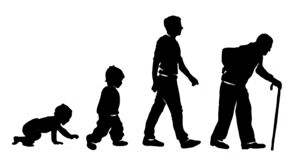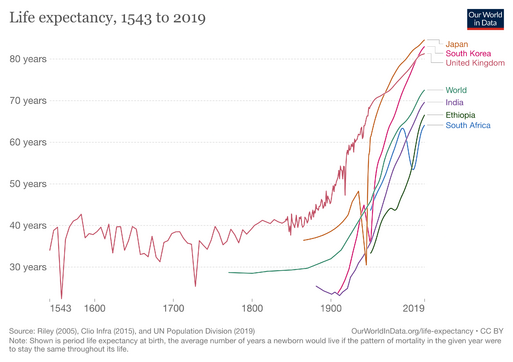Older People - An Introduction: Difference between revisions
Lauren Lopez (talk | contribs) No edit summary |
Kim Jackson (talk | contribs) m (Text replacement - "[[Cognitive Deficits" to "[[Cognitive Impairments") |
||
| (31 intermediate revisions by 6 users not shown) | |||
| Line 3: | Line 3: | ||
'''Top Contributors''' - {{Special:Contributors/{{FULLPAGENAME}}}} | '''Top Contributors''' - {{Special:Contributors/{{FULLPAGENAME}}}} | ||
</div> | </div> | ||
== | == Ageing == | ||
[[File:Human ageing.jpg|thumb|Human ageing]] | |||
The most widely held view of ageing is that it is just a part of the life cycle. That is a progressive physiological cycle leading to senescence, or a decline of biological functions and of the bodies ability to adapt to metabolic stress. Ageing is also seen as a wide-ranging event being a physical process, a psychological one and a social one. On the upside we acquire positive values, for example knowledge and experience. <ref>Senesienca What is ageing Available:http://www.ub.edu/senesciencia/noticia/what-is-ageing/ (accessed 12.11.2022)</ref> | |||
Watch this 5 minute video on why we age.{{#ev:youtube|https://www.youtube.com/watch?v=GASaqPv0t0g|width}}<ref>Ted ed Why do our bodies age. Available from: https://www.youtube.com/watch?v=GASaqPv0t0g (last accessed 23.5.2019)</ref> | |||
See also [[Theories of Aging|'''Theories of Ageing''']] | |||
The | == Divisions Of The Aged == | ||
[[File:Ageing.jpeg|thumb|Older People]] | |||
An arbitrary division exists with three ages of ‘old’, a starting point for considering the span of old age<ref>World Health Organisation. [http://www.searo.who.int/entity/health_situation_trends/data/chi/elderly-population/en/ Health situation and trend assessment: elderly population]. Accessed 26 September 2018.</ref><ref>World Health Organisation. [http://www.who.int/healthinfo/survey/ageingdefnolder/en/ Health statistics and information systems: Proposed working definition of an older person in Africa for the MDS Project]. Accessed 26 September 2018.</ref><ref>The CALAS Team at Tel Aviv University: Cohen-Mansfield J, Shmotkin D, Blumstein Z, Shorek A, Eyal N, Hazan H. [http://journals.sagepub.com/doi/abs/10.2190/AG.77.1.c?journalCode=ahdb The Old, Old-Old, and the Oldest Old: Continuation or Distinct Categories? An Examination of the Relationship between Age and Changes in Health, Function, and Wellbeing]. Int J Aging Hum Dev2013; 77 (1): 37-57. | |||
</ref> | |||
#Between 60 – 75 years = young old | #Between 60 – 75 years = young old | ||
| Line 20: | Line 21: | ||
#Those 85+ are considered the frail older population | #Those 85+ are considered the frail older population | ||
As populations age, it will be of interest to see if these age bands alter. | As populations age, it will be of interest to see if these age bands alter. | ||
The National Service Framework for Older People<ref name="NSF OP">Department of Health (2001). [https://www.gov.uk/government/publications/quality-standards-for-care-services-for-older-people National Service Framework for Older People]. London, HMSO. Accessed 26 September 2018.</ref> (UK 2001) categorised three groups: | |||
#Entering old age: People from 50 to the official retirement age who have completed their career. They are supposed active and independent and many remain so into late old age. | |||
#Transitional phase: A group in transition between healthy, active life and frailty, often occurring in the seventh or eighth decades, but can occur at any stage. | |||
#Frail older people: A vulnerable group due to health problems e.g. stroke or dementia, social care needs or a combination of both. [[Introduction to Frailty|Frailty]] often experienced in late old age, so services people should be designed with their needs in mind.<br> | |||
== | == Views On Ageing == | ||
Traditionally, ageing was viewed as a negative process, leading to loss 0f social, physical and cognitive domains. In the 1980′s the views on ageing changed, with a more positive outlook on ageing, including a focus on successful ageing. However a new construct of ageing is emerging. In reality ageing for most older persons includes adversities such as illness, disability, loneliness, and [[Cognitive Impairments|cognitive impairment]]. Resilience in ageing is now viewed a being a critical factor. Resilience allows older persons to deal with, or doing well despite adversities; a goal that can be achieved regardless of the circumstances. This construct is considered a positive and more general one, that does justice to the reality of ageing: a complex process with a mix of gains and losses.<ref>Angevaare MJ, Roberts J, van Hout HP, Joling KJ, Smalbrugge M, Schoonmade LJ, Windle G, Hertogh CM. Resilience in older persons: A systematic review of the conceptual literature. Ageing research reviews. 2020 Nov 1;63:101144.Available: https://www.sciencedirect.com/science/article/pii/S1568163720302798?via%3Dihub<nowiki/>(accessed 12.11.2022)</ref> | |||
We can however take steps to have a healthy, longer life. See the video below. | |||
{{#ev:youtube|https://www.youtube.com/watch?v=qSt8aKtpDCA|width}}<ref>Scripps Research The Science of Healthy Aging: Six Keys to a Long, Healthy Life Available from: https://www.youtube.com/watch?v=qSt8aKtpDCA (last accessed 12.11.2022)</ref> | |||
== Life Expectancy == | |||
[[File:Life-expectancy.png|thumb|513x513px|Life expectancy 1543 to 2019]] | |||
Human life expectancy has increased dramatically<ref>Lutz W, Sanderson WC, Scherbov S. Global and regional population ageing: How certain are we of its dimensions? Population Ageing. 2008; 1 (1): 75-97.</ref>. Estimates suggest that in a pre-modern world, life expectancy was around 30 years in all regions of the world. Since 1900 the global average life expectancy has increased by more than 50%, and is now above 70 years. The imbalance of life expectancy is great across and within countries. eg in 2019 the country with the lowest life expectancy is the Central African Republic with 53 years, in Japan life expectancy is 83.<ref>Our world in data Life expectancy Available:https://ourworldindata.org/life-expectancy (accessed 11.11.2022)</ref> | |||
The ageing of the population will have far-reaching implications for society. Direct challenges for the health system will consist of: changing health profiles; increased demand for health service use; rising health costs. The main challenges will be: | |||
# The rapidly growing group of ‘old old’ (85 and over) people who have a variety of typical age-related health problems (eg., [[arthritis]], [[dementia]] and [[Oncology|cancer]]) | |||
# The younger group entering the ‘65 and over’ age bracket with a larger burden of lifestyle related diseases (eg, [[obesity]], [[Metabolic Syndrome|metabolic syndrome]], [[Diabetes Mellitus Type 2|type 2 diabetes]]) than previous generations. | |||
< | == Digital Technologies and Ageing == | ||
The below video details "Digital technologies for older persons and healthy ageing" details how digital technologies can empower the older person.{{#ev:youtube|v=Vrg51jT31GA|300}}<ref>ITU Digital technologies for older persons and healthy ageing.. The Evolution of Dance. Available from:https://www.youtube.com/watch?v=Vrg51jT31GA [last accessed 12.11.2022]</ref> | |||
[[ | == Physiotherapy Implications == | ||
For [[Physiotherapy and Older People|physiotherapists working with the older population,]] one goal is the facilitation of an individual's''' '''later years to be active and a time of good health, although for some people it is a period of loss of health, wealth and status due to retirement from work, or loss from bereavement. | |||
Although no amount of [[Physical Activity|physical activity]] can stop the biological ageing process, there is evidence that regular [[Therapeutic Exercise|exercise]] can minimize the physiological effects of an otherwise sedentary lifestyle and increase active life expectancy by limiting the development and progression of [[Chronic Disease|chronic disease]] and disabling conditions. There is also emerging evidence for significant psychological and [[Cognitive Impairments|cognitive]] benefits accruing from regular exercise participation by older adults. | |||
Ideally, [[Principles of Exercise|exercise prescription]] for older adults should include [[Aerobic Exercise|aerobic]] exercise, muscle [[Strength Training|strengthening]] exercises, and [[flexibility]] exercises.<ref>[[Age and Exercise]]</ref><br> | |||
< | |||
</ | |||
== Resources == | == Resources == | ||
| Line 77: | Line 62: | ||
[[Category:Older_People/Geriatrics]] | [[Category:Older_People/Geriatrics]] | ||
[[Category:Occupational Health]] | |||
[[Category:Older People/Geriatrics - Anatomy]] | |||
[[Category:Older People/Geriatrics - Conditions]] | |||
[[Category:Conditions]] | |||
[[Category:Anatomy]] | |||
[[Category:AGILE Project]] | |||
Latest revision as of 11:16, 17 February 2023
Original Editor - Bhanu Ramaswamy as part of the AGILE Project.
Top Contributors - Admin, Bhanu Ramaswamy, Lucinda hampton, Lauren Lopez, Wendy Walker, Kim Jackson, Rachael Lowe, Vidya Acharya and Amrita Patro
Ageing[edit | edit source]
The most widely held view of ageing is that it is just a part of the life cycle. That is a progressive physiological cycle leading to senescence, or a decline of biological functions and of the bodies ability to adapt to metabolic stress. Ageing is also seen as a wide-ranging event being a physical process, a psychological one and a social one. On the upside we acquire positive values, for example knowledge and experience. [1]
Watch this 5 minute video on why we age.
See also Theories of Ageing
Divisions Of The Aged[edit | edit source]
An arbitrary division exists with three ages of ‘old’, a starting point for considering the span of old age[3][4][5]
- Between 60 – 75 years = young old
- Between 75 – 85 years = old
- Those 85+ are considered the frail older population
As populations age, it will be of interest to see if these age bands alter.
The National Service Framework for Older People[6] (UK 2001) categorised three groups:
- Entering old age: People from 50 to the official retirement age who have completed their career. They are supposed active and independent and many remain so into late old age.
- Transitional phase: A group in transition between healthy, active life and frailty, often occurring in the seventh or eighth decades, but can occur at any stage.
- Frail older people: A vulnerable group due to health problems e.g. stroke or dementia, social care needs or a combination of both. Frailty often experienced in late old age, so services people should be designed with their needs in mind.
Views On Ageing[edit | edit source]
Traditionally, ageing was viewed as a negative process, leading to loss 0f social, physical and cognitive domains. In the 1980′s the views on ageing changed, with a more positive outlook on ageing, including a focus on successful ageing. However a new construct of ageing is emerging. In reality ageing for most older persons includes adversities such as illness, disability, loneliness, and cognitive impairment. Resilience in ageing is now viewed a being a critical factor. Resilience allows older persons to deal with, or doing well despite adversities; a goal that can be achieved regardless of the circumstances. This construct is considered a positive and more general one, that does justice to the reality of ageing: a complex process with a mix of gains and losses.[7]
We can however take steps to have a healthy, longer life. See the video below.
Life Expectancy[edit | edit source]
Human life expectancy has increased dramatically[9]. Estimates suggest that in a pre-modern world, life expectancy was around 30 years in all regions of the world. Since 1900 the global average life expectancy has increased by more than 50%, and is now above 70 years. The imbalance of life expectancy is great across and within countries. eg in 2019 the country with the lowest life expectancy is the Central African Republic with 53 years, in Japan life expectancy is 83.[10]
The ageing of the population will have far-reaching implications for society. Direct challenges for the health system will consist of: changing health profiles; increased demand for health service use; rising health costs. The main challenges will be:
- The rapidly growing group of ‘old old’ (85 and over) people who have a variety of typical age-related health problems (eg., arthritis, dementia and cancer)
- The younger group entering the ‘65 and over’ age bracket with a larger burden of lifestyle related diseases (eg, obesity, metabolic syndrome, type 2 diabetes) than previous generations.
Digital Technologies and Ageing[edit | edit source]
The below video details "Digital technologies for older persons and healthy ageing" details how digital technologies can empower the older person.
Physiotherapy Implications[edit | edit source]
For physiotherapists working with the older population, one goal is the facilitation of an individual's later years to be active and a time of good health, although for some people it is a period of loss of health, wealth and status due to retirement from work, or loss from bereavement.
Although no amount of physical activity can stop the biological ageing process, there is evidence that regular exercise can minimize the physiological effects of an otherwise sedentary lifestyle and increase active life expectancy by limiting the development and progression of chronic disease and disabling conditions. There is also emerging evidence for significant psychological and cognitive benefits accruing from regular exercise participation by older adults.
Ideally, exercise prescription for older adults should include aerobic exercise, muscle strengthening exercises, and flexibility exercises.[12]
Resources[edit | edit source]
There are several resources with interactive graphics to view different data and statistics on ageing health and populations:
- Life Expectancy by Max Roser (2015).
- United Nations Global Health Observatory (GHO) data pages which give health data and general statistics about each country.
- The Gapminder graphic which illustrates the demographic changes of global populations over the age of 60, and their pattern of growth from 1950 to a predicted older population in 2050.
- Help Age International pages.
References[edit | edit source]
- ↑ Senesienca What is ageing Available:http://www.ub.edu/senesciencia/noticia/what-is-ageing/ (accessed 12.11.2022)
- ↑ Ted ed Why do our bodies age. Available from: https://www.youtube.com/watch?v=GASaqPv0t0g (last accessed 23.5.2019)
- ↑ World Health Organisation. Health situation and trend assessment: elderly population. Accessed 26 September 2018.
- ↑ World Health Organisation. Health statistics and information systems: Proposed working definition of an older person in Africa for the MDS Project. Accessed 26 September 2018.
- ↑ The CALAS Team at Tel Aviv University: Cohen-Mansfield J, Shmotkin D, Blumstein Z, Shorek A, Eyal N, Hazan H. The Old, Old-Old, and the Oldest Old: Continuation or Distinct Categories? An Examination of the Relationship between Age and Changes in Health, Function, and Wellbeing. Int J Aging Hum Dev2013; 77 (1): 37-57.
- ↑ Department of Health (2001). National Service Framework for Older People. London, HMSO. Accessed 26 September 2018.
- ↑ Angevaare MJ, Roberts J, van Hout HP, Joling KJ, Smalbrugge M, Schoonmade LJ, Windle G, Hertogh CM. Resilience in older persons: A systematic review of the conceptual literature. Ageing research reviews. 2020 Nov 1;63:101144.Available: https://www.sciencedirect.com/science/article/pii/S1568163720302798?via%3Dihub(accessed 12.11.2022)
- ↑ Scripps Research The Science of Healthy Aging: Six Keys to a Long, Healthy Life Available from: https://www.youtube.com/watch?v=qSt8aKtpDCA (last accessed 12.11.2022)
- ↑ Lutz W, Sanderson WC, Scherbov S. Global and regional population ageing: How certain are we of its dimensions? Population Ageing. 2008; 1 (1): 75-97.
- ↑ Our world in data Life expectancy Available:https://ourworldindata.org/life-expectancy (accessed 11.11.2022)
- ↑ ITU Digital technologies for older persons and healthy ageing.. The Evolution of Dance. Available from:https://www.youtube.com/watch?v=Vrg51jT31GA [last accessed 12.11.2022]
- ↑ Age and Exercise









